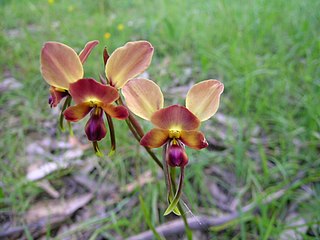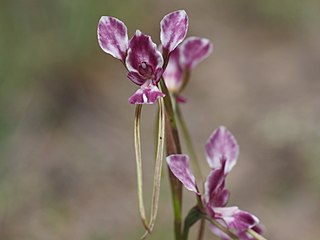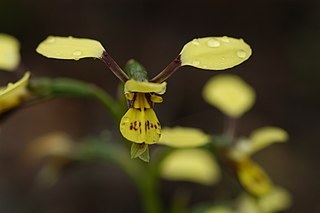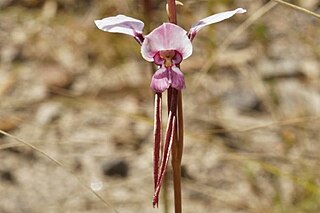
Diuris behrii, commonly known as golden cowslips, is a species of orchid which is endemic to eastern Australia. It occurs in South Australia, Victoria, New South Wales and the Australian Capital Territory. It has between three and six grass-like leaves and a flowering stem with up to four drooping, yellow flowers with dark streaks on the labellum. The flowers appear between September and November in its native range.

Diuris orientis, commonly called the wallflower orchid or eastern wallflower orchid, is a species of orchid which is endemic to eastern Australia. Like others in the genus Diuris, it has two ear-like petals and is similar to the common donkey orchid of Western Australia with which it has been confused. This species is found in New South Wales, Victoria, South Australia and Tasmania and its stalk-like petal "claw" is shorter in than those of D. corymbosa.

Diuris venosa, commonly known as the veined doubletail is a species of orchid which is endemic to New South Wales. It has a few thin, erect leaves and up to four white to lilac-coloured flowers with deep red to purple blotches and lines.

Diuris alba, commonly called the white donkey orchid, is a species of orchid which is endemic to eastern Australia. It has up to three leaves, and a flowering stem with up to seven white flowers with purplish markings.

Diuris abbreviata, commonly known as the lemon doubletail, is a species of orchid that is endemic to eastern Australia. It has two or three leaves and a flowering stem with up to nine yellow flowers with darker markings.

Diuris dendrobioides, commonly known as the wedge diuris, is a species of orchid which is endemic to eastern Australia. It has one or two leaves and a flowering stem with up to six pale lilac-coloured to mauve flowers with darker markings.

Diuris praecox, commonly known as the early doubletail, Newcastle doubletail or rough doubletail is a species of orchid which is endemic to New South Wales. It has two or three grass-like leaves and up to ten light yellow flowers with a few dark brown marks. It is threatened by urbanisation.

Diuris punctata, commonly known as the purple donkey orchid is a species of orchid which is endemic to south-eastern continental Australia. It has two grass-like leaves and up to ten purple or mauve flowers, often with darker, sometimes yellow marks. A yellow form from near Guyra is probably now extinct.

Diuris arenaria, commonly known as the Tomaree donkey orchid or sand doubletail is a species of orchid which is endemic to a very small area of New South Wales. It has two grass-like leaves and up to nine mauve or light purple and white flowers. It has a very limited distribution near Newcastle.
Diuris bracteata is a species of orchid that is endemic to New South Wales. It has two folded leaves and up to eight yellow flowers with blackish marks. After its collection in a Sydney suburb in 1888, no further collections were made and the species was presumed extinct until 2004 when it was rediscovered near Gosford.
Diuris disposita, commonly called the Macleay River doubletail or Willawarrin doubletail, is a species of orchid which is endemic to a small area in New South Wales. It has one or two linear leaves at its base and up to seven yellow flowers with brown markings. Only about fifty plants survive in grassy forest near Kempsey.
Diuris flavescens, commonly called the pale yellow doubletail or Wingham doubletail, is a species of orchid which is endemic to a small area in New South Wales. It has two linear leaves at its base and up to five pale yellow flowers with dark brown markings. Fewer than 200 plants survive in grassy forest near Wingham.
Diuris fragrantissima, commonly called the fragrant doubletail or Sunshine diuris, is a species of orchid which is endemic to a small area to the west of Melbourne. It has two linear leaves at its base and up to twelve white flowers with mauve or pale purple markings with unusually long lateral sepals. Only about thirty plants survive in grassland near Sunshine.

Diuris oporina, commonly called the autumn donkey orchid or northern white donkeys tails is a species of orchid that is endemic to Queensland. It has a single tapering, linear leaf at its base and up to ten white flowers with mauve to purple markings. It grows in the drier parts of the tablelands in Far North Queensland.

Diuris platichila, commonly known as the Blue Mountains doubletail, is a species of orchid that is endemic to a few isolated places in the Blue Mountains in New South Wales. It has two leaves and up to eight yellow flowers with dark markings on the dorsal sepal and labellum. It has relatively long, thin lateral sepals and the central lobe of the labellum is wedge-shaped. It forms hybrids with other species of Diuris.

Diuris pulchella, commonly called the beautiful donkey orchid is a species of orchid that is endemic to the south-eastern part of the south-west of Western Australia. It has two or three leaves at its base and up to five bright yellow and mauve flowers described as "exquisite", "spectacular" and "attractive". It grows in shallow soil on granite outcrops near Esperance.
Diuris secundiflora, commonly known as the one-sided donkey orchid, is a poorly-known species of orchid that is endemic to New South Wales. It has a single grass-like leaf and up to eight yellow flowers that are sometimes spotted and are all arranged on one side of the flowering stem.

Diuris semilunulata, commonly known as the late leopard orchid, is a species of orchid that is endemic to New South Wales and the Australian Capital Territory. It has two grass-like leaves and up to five orange-coloured flowers with brown and purple blotches.

Diuris tricolor, commonly known as the long-tailed donkey orchid or pine donkey orchid, is a species of orchid that is endemic to eastern Australia. It has up to three grass-like leaves and up to six orange-coloured to yellow flowers with white and purplish tints. The lateral sepals are unusually long.

Diuris goonooensis, commonly known as Goonoo donkey orchid or western donkey orchid, is a species of orchid that is endemic to western New South Wales. It has one or two linear leaves at its base and up to eight yellow flowers with brown markings on each part of the flower.














